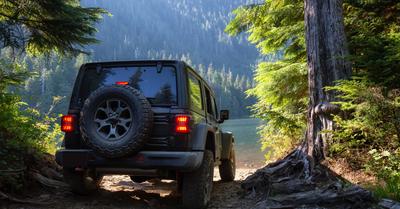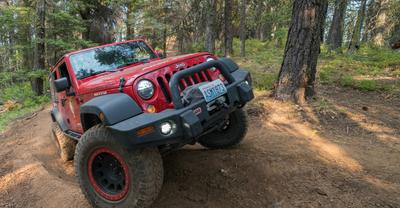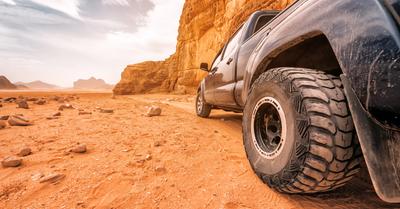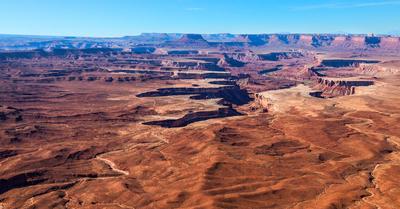As the owner of an off-roading vehicle with auxiliary lights, you must have wondered, “Do off-road lights need to be covered?” Read on to find out!
When taking your vehicle on a public roadway, you should cover your off-road lights to avoid blinding oncoming drivers and causing accidents. Most states ban the use of off-road lights on public roads and highways and ask drivers to cover them with an opaque cover.
Off-road lights help drivers navigate dark trails at night and help them watch out for potential hazards, unsuspecting critters, and obstacles they might find in their way. However, the same lights can cause a nuisance when used on busy public roads and highways. They can potentially blind oncoming traffic, resulting in preventable collisions. It’s why many states require you to cover these lights.
As someone who has driven off-road vehicles for quite a few years now, I have ample knowledge about off-road light usage on public roadways and whether they need to be covered or not. Here’s everything you need to know about covering off-road lights:
This article may contain affiliate links where we earn a commission from qualifying purchases.
Do I Need to Cover Off-Road Lights on Local Roads?
When you’re taking your off-roading vehicle on an adventure in the evening or night, you will need additional lights since your headlight cannot provide ample lighting for you to see where you’re going correctly. It’s because your vehicle will likely be the sole light source on an off-roading journey. You will need the supplemental lights to see potential obstacles and hazards that might come in your way.
With that said, adding an extra set of lights or headlamps to your off-road vehicle doesn’t mean that you can use said lights when traveling on local roads and highways. It’s because these lights can potentially blind the other drivers on the road, resulting in avoidable car collisions and other accidents.
That naturally brings us to the question, “Do off-road lights need to be covered?
Since these additional off-road lights are not necessarily legal for street use, the local laws in your area might require you to cover them when you’re driving your vehicle on public highways and roads. Currently, there are no federal laws in the US to address the use of off-road lights while traveling on public roadways. However, different states have different regulations for covering off-road lights.
The Law Varies State to State
Some states require drivers to cover all additional lights, but others only require you to cover lights mounted above your headlights. To ensure that you comply with the local laws, you need to check the specific guidelines laid down by your state.
With that said, the use of additional off-roading lights on public roads is illegal in every state, but there are minor variations in the laws. If you don’t comply with the local safety laws in your area, you can end up paying hefty fines to the state.
Local Laws on Covering Off-Road Lights
Local Laws on these auxiliary lights are regulated in every state. But there are two common types of regulations in these laws. The first one states that you don’t need to cover lights mounted within the state’s approved height limits.
Typically, these lights should be installed within the headlight height range of the vehicle. Some states stipulate the maximum and minimum heights, while others mention the maximum height only. In certain states, if you mount two auxiliary lights within the specified range on the front of your vehicle, they will be considered as a high beam light. In such cases, you will not have to cover them.
However, if you have more than two extra lights at this length or mount a light outside the stipulated height limit, you will need to cover the additional lights. So, you cannot have a total of more than four front-mounted lights on your vehicle (two mandated headlights and two auxiliary lights) within the stipulated range. Otherwise, you will need to cover the extra ones.
The second regulation for auxiliary off-road lights, followed by some states, requires that any lights that are not mandated headlights, brake lights, turn signals, etc., need to be covered when driving on public highways and roads. Regardless of their height, you must cover all auxiliary lights to avoid fines.
Types of Off-Roading Lights
Today, you can invest in a wide array of auxiliary off-roading lights, such as light bars, spotlights, directional lamps, and more. Regardless of the type of additional light you buy for your off-roading travels, make sure to purchase opaque covers for them as well.
The type of light you end up buying will depend on your needs and intended purpose. For instance, you might need to invest in a swivel-mounted light, which you can essentially position from inside your vehicle to light up a dark trail when traveling at night. It will help you watch out for potential hazards.
However, some states have prohibited swivel lights, even with covers. If your vehicle is seen with a swivel light mounted on it, you will get in trouble in these states. Certain states also have exceptions for aftermarket lighting on plow-mounted vehicles. If your plow covers the manufacturer-installed lights, you can mount additional lights onto your vehicle without worrying about paying a fine.
Moreover, even though most vehicles come with pre-installed fog lights, many states consider them auxiliary lights. It means that they are counted in the law that stipulated a maximum of four uncovered lights in the given height range are allowed on public roadways. So, make sure to check your state laws regarding these auxiliary lights to avoid getting yourself into trouble with the authorities.
Covers for Off-Road Lights
Once you have invested in the right auxiliary off-road lights for your vehicle, you will need to find the ideal covers for them. When it comes to using covers for off-road vehicles, you need to adhere to two principal regulations:
- The covers must be completely opaque
- They must complete the entire lights
The first regulation entails that the covers you use for your off-road lights need to be opaque, i.e., they should not allow any light to pass through them at all. If they are even slightly translucent, the light will pass through.
The second stipulation is that they need to obstruct all the light coming from your auxiliary off-road lamps or lights. You cannot cover half the light and call it a day. You also cannot use covers that will redirect the light. Instead, you need covers that will eliminate the light emitting from the sources.
When you’re heading on an off-road journey that spans multiple states, make sure to keep your off-road light covers on you. It’s because you will be subject to the laws of all the states you travel to, and their laws might be different from the laws in your state. So, to maintain your compliance with the law, it’s best to use off-road light covers when traveling on public roadways, especially when crossing state lines.
Why Do I Need to Cover My Off-Road Lights?
Off-road lights are bright, and most vehicles don’t have them pre-installed to prevent the blinding light they emit from obstructing the view of oncoming drivers on busy roads and highways. After all, shining a bright light into the eyes of an approaching driver can prove to be dangerous, even fatal in some cases.
These lights can temporarily blind drivers and cause their pupils to dilate. It essentially means they won’t be able to see in the dark for some time after being exposed to the light from these auxiliary off-road lamps. The lack of sight can cause them to ram their vehicle into oncoming traffic. So, to avoid such accidents and ensure driver safety, you need to cover these lights when traveling on public roads.
Where Can I Use Off-Road Lights without Covers?
You can use off-road lights on trails that stretch beyond the public roadways. These lights are often used on large private properties, such as farms. You can also use them on service roads and off-road trails. However, you cannot use them on public roads, city streets, highways, and even backroads.









